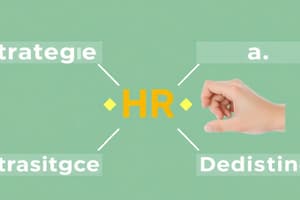Podcast
Questions and Answers
What is NOT a consequence of poor HR decisions?
What is NOT a consequence of poor HR decisions?
- Increased costs
- Low morale
- High client satisfaction (correct)
- Loss of clients
Employee selection does not require a screening process.
Employee selection does not require a screening process.
False (B)
What directly influences HR planning?
What directly influences HR planning?
Strategic plan goals
The seven key activities in HR management include planning, selecting, orienting, training, __________, rewarding, and termination.
The seven key activities in HR management include planning, selecting, orienting, training, __________, rewarding, and termination.
What is a key advantage of internal recruitment?
What is a key advantage of internal recruitment?
External recruitment does not introduce any new perspectives into a company.
External recruitment does not introduce any new perspectives into a company.
What is analyzed by an application form during the candidate screening process?
What is analyzed by an application form during the candidate screening process?
The final step in the hiring process involves reviewing all ______ before offering employment.
The final step in the hiring process involves reviewing all ______ before offering employment.
Which of the following is NOT a focus of training mentioned in the content?
Which of the following is NOT a focus of training mentioned in the content?
Employee rewards should be aligned with sales performance and service quality.
Employee rewards should be aligned with sales performance and service quality.
What is the main purpose of performance reviews?
What is the main purpose of performance reviews?
The process of ______ involves assessing a candidate's fit with the brokerage.
The process of ______ involves assessing a candidate's fit with the brokerage.
Which of the following describes the role of leadership development?
Which of the following describes the role of leadership development?
Flashcards
HR Management Key Activities
HR Management Key Activities
Planning, selecting, orienting, training, managing performance, rewarding, and terminating employees to support organizational goals.
HR Planning
HR Planning
Aligning HR activities with long-term organizational goals using current capabilities and future needs.
Job Description
Job Description
A detailed description of a job's role including responsibilities and qualifications.
Employee Selection
Employee Selection
Signup and view all the flashcards
Recruitment Methods
Recruitment Methods
Signup and view all the flashcards
Training Importance
Training Importance
Signup and view all the flashcards
Performance Management
Performance Management
Signup and view all the flashcards
Performance Reviews
Performance Reviews
Signup and view all the flashcards
Training plan objectives
Training plan objectives
Signup and view all the flashcards
Quality service training
Quality service training
Signup and view all the flashcards
Employee Rewards
Employee Rewards
Signup and view all the flashcards
Termination Process
Termination Process
Signup and view all the flashcards
Study Notes
Introduction to Human Resources Management
- Human Resources (HR) Management involves selecting capable employees to achieve strategic organizational goals.
- Good HR decisions lead to high morale, reduced costs, enhanced client service, and client retention.
- Poor HR decisions can result in low morale, increased costs, poor client service, and client losses.
Key Activities in HR Management
- Planning: Align HR planning with strategic goals and employee needs.
- Selecting: Implement processes for effective hiring practices.
- Orienting: Integrate new hires into the company culture and values.
- Training: Invest in employee development through structured training programs.
- Managing Performance: Monitor and guide employee performance continuously.
- Rewarding: Create incentive systems linked to performance and service quality.
- Termination: Conduct clear and fair separation processes when necessary.
HR Planning
- HR planning is directly linked to the organization's strategic plan.
- Requires assessment of current capabilities against future needs to avoid last-minute hiring.
- Key elements include defining needed skills, establishing hiring timelines, and contingency plans for challenges.
Job Descriptions in HR Planning
- Job descriptions clarify roles with specific qualifications, responsibilities, and expected behaviors.
- Essential for creating structured recruitment processes.
Employee Selection Process
- Involves recruitment, screening, and interviewing candidates using fair methods adhering to legal standards.
- Application forms and resumes are used for consistency and insight into candidate qualifications.
Recruitment Methods
- Internal Recruitment: Cost-effective, shorter vacancy periods, improves morale.
- External Recruitment: Introduces fresh talent and perspectives.
Screening and Interviewing
- Use standardized methods for fairness in candidate evaluation.
- Federal and provincial laws guide fair employment practices.
Importance of Employment Interviews
- Assess candidates’ fit with the company culture.
- May require multiple interview stages to thoroughly evaluate candidates.
Testing and Reference Checks
- Conduct tests for skills and knowledge related to the job.
- Reference checks provide critical insights into a candidate's past performance.
Final Hiring Steps
- Comprehensive review of all candidate information.
- Offer letter and employment contract preparation, including non-piracy clauses for insurance brokerages.
Orientation Process
- Communicate brokerage values and policies to new employees.
- Set early performance expectations and timelines for reviews.
Importance of Training
- Ongoing training is essential for employee development and aligns with the strategic plan.
- Viewed as an investment in organizational growth.
Crafting a Training Plan
- Training plans should define objectives, target audience, content, and delivery methods.
- Focus areas include service, sales, product knowledge, and leadership development.
Quality Service Training
- Emphasizes client satisfaction, problem-solving, and employee empowerment.
Sales Training Essentials
- Techniques include consultative selling and relationship building.
Product and Service Knowledge
- Clients expect technical competence, which leads to increased referral opportunities.
Leadership Development
- Shift focus from management to leading by empowering employees and providing coaching.
Career Path Development
- Establish clear career paths for employee growth, emphasizing sales and relationship-building skills.
Employee Rewards and Incentives
- Align incentive structures with service quality and client satisfaction to reinforce desired behaviors.
Performance Management
- Balance quantitative and qualitative performance measures.
- Regular feedback and progress tracking are essential for effective performance management.
Conducting Performance Reviews
- Utilize ongoing feedback throughout the year leading to formal performance evaluations.
Termination Process
- Conduct final performance reviews with transparent communication regarding the termination.
Conclusion: Impact of HR Management
- HR management serves as a strategic tool linked to long-term success through employee development and performance management.
Studying That Suits You
Use AI to generate personalized quizzes and flashcards to suit your learning preferences.




